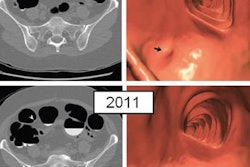
About 10% of all polyps detected at CT colonography (CTC) can't be found at initial colonoscopy follow-up. But the reasons for their disappearance are largely predictable, according to a study presented at the 2013 RSNA meeting.
Results from more than 7,000 screening subjects at the University of Wisconsin showed that most CTC-detected polyps "lost" at follow-up with conventional colonoscopy were on the right side of the colon. Such polyps were also more likely to be flat, and physicians were likely to have less confidence when diagnosing them.
Also, surprisingly, about 35% appear to be false negatives at conventional colonoscopy, according to the study team.
A monkey wrench
Polyps that disappear between CTC and follow-up throw a monkey wrench into the entire colon cancer screening process. Therefore, the current study was undertaken to shed light on what happens to them, said third-year resident Dr. Dustin Pooler in his RSNA presentation.
"The purpose of this study was to look at polyps detected at CTC screening and analyze the differences between polyps confirmed at initial endoscopy versus those not found, and to try to sort of tease out the difference between those groups of polyps," Pooler said.
In screening CTC (also known as virtual colonoscopy), patients with polyps 10 mm or larger are categorically referred for endoscopic follow-up and removal, but at the University of Wisconsin there's some wiggle room for patients with one or two 6- to 9-mm polyps. These individuals are given the option of polyp surveillance, whereby the small lesions are left for two to three years, according to Pooler.
 University of Wisconsin investigators Dr. Dustin Pooler (left) and Dr. Perry Pickhardt.
University of Wisconsin investigators Dr. Dustin Pooler (left) and Dr. Perry Pickhardt.The retrospective study included 7,157 consecutive adults (mean age, 56.6 years) undergoing first-time CTC screening. A total of 1,051 patients were found to have polyps 6 mm and larger. Of these, 751 underwent colonoscopy or flexible sigmoidoscopy with polypectomy, while 300 with 6- to 9-mm lesions opted for polyp surveillance.
Among the 1,272 CTC-detected polyps, 90.6% (n = 1,153) were confirmed and 9.4% (n = 119) were discordant. The researchers compared size, morphology, diagnostic confidence, and other factors, and they performed additional follow-up with CTC and optical colonoscopy to determine the reason for the discordance, such as whether it was a CTC false positive or an optical colonoscopy false negative, Pooler said.
To be considered concordant, polyps were within 50% of the size estimated at CTC and within one adjacent segment at conventional colonoscopy.
The results showed that polyp morphology played a role in "disappearance": If the polyp was flat, the odds ratio (OR) was as high as 4.0 that it would be discordant, compared with polyps that were pedunculated (0.38) or sessile (0.50), Pooler said.
As for polyp location, the group found that "polyps within the right colon -- that is, cecum, ascending, and transverse colon -- were much more likely not to be found, while polyps on the left side of the colon were much more likely to be found by the endoscopist," Pooler said. "This makes sense intuitively, as endoscopy starts in the rectum and proceeds in a retrograde fashion."
| Odds of CTC-detected polyps not being visible by location | |||
| Segment | Concordant | Discordant | Odds ratio |
| Ascending | 85.1% | 14.9% | 2.0 |
| Cecum | 85.2% | 14.8% | 1.8 |
| Transverse | 90.0% | 10.0% | 1.1 |
| Rectum | 92.6% | 7.4% | 0.74 |
| Descending | 93.2% | 6.8% | 0.69 |
| Sigmoid | 95.1% | 4.9% | 0.40 |
| All right colon | 86.6% (n = 512) | 13.4% (n = 79) | 2.4 |
| All left colon | 94.1% (n = 641) | 5.9% (n = 40) | 0.4 |
| Odds of CTC-detected polyps not being visible by diagnostic confidence | |||
| Confidence | Concordant | Discordant | Odds ratio |
| Most | 97.5% | 2.5% | 0.13 |
| Moderate | 95.7% | 14.3% | 4.8 |
| Least | 68.8% | 31.3% | 9.5 |
Polyps with the most diagnostic confidence at initial CTC evaluation were much less likely to be discordant than those identified with moderate or the least amount confidence.
However, the lack of a true gold standard was a limitation of the study, Pooler said. In addition, the study was performed in a single academic center, and many of the 6- to 9-mm polyps were in surveillance and thus could not be measured at colonoscopy.
"About 10% of polyps detected at CTC will not be detected at initial endoscopic follow-up," he concluded. "Discordant polyps are significantly more likely to be flat, located in the right colon, and called with lower diagnostic confidence, and about one-third were found to be colonoscopy false negatives."



















